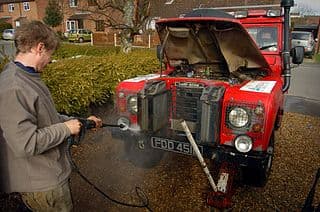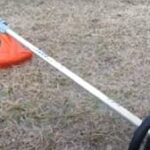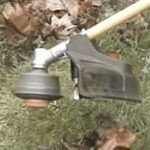As an Amazon Associate, this site earns commissions from qualifying purchases. For more information click here.
A flooded pressure washer engine can be alarming, especially if it is your first time to deal with it. Fortunately there is a solution to this that you can do yourself. No need for fancy equipment here, as this post will explain what you need to do every step of the way.
To clear a flooded pressure washer, remove the spark plug first. Turn the choke lever off by pushing the control lever. Keep the throttle control lever down and pull the start rope a minimum of 9 times. When the flood clears, wipe away the oil on spark plug and put it back on.
How to Clear a Flooded Pressure Washer
The following shows you step by step how to un-flood a pressure washer engine. These instructions are for two-stroke engines as they make up most pressure washers today. Before you start, look into your owner’s manual and find out where the spark plug is.
Keep in mind that two-stroke models like the Westinghouse WPX3200 use both oil and gas in the engine. The gas supplies the power to the engine and the oil lubricates various parts.
Required Tools and Materials
- Owner’s manual
- Spark plug wrench
- Wraparound protective goggles
- Rag or any piece of clothing
Step 1. Find the spark plug and take it off. You will need to rotate it counterclockwise with a spark plug wrench.
Step 2. Once the spark plug has come loose, carefully remove it. Some oil might splash so make sure to wear protective goggles.
Step 3. Look for the engine choke lever and push it in. This will shut the choke down. Keeping the choke lever depressed, pull the start rope at least 9 times. You may have to pull several more just to get the engine running.
Step 4. Once the pressure washer has been un-flooded, use the rag to wipe away excess oil.
If the problem persists, it could be due to too much air. To fix this, get a screwdriver and remove the air filter cover. Once the cover is gone you will see the air filter. Take out the air filter. Put the screwdriver into the air intake valve so it balances the air with the gas inside.
Safety Tips. Wait for the engine to cool down before attempting to un-flood it. Modern pressure washers like the WEN PW3200 are safe to use, but you can never be too careful. If the exhaust system is too hot, it increases the risk of automatic ignition. This could suddenly produce an engine fire so be careful.
Reasons Why a Pressure Washer Gets Flooded
Engines get flooded when the air and fuel mixture surpasses the engine capacity. Any engine that gets flooded will not be able to operate.
There are many other reasons why a pressure washer gets flooded. The following are the most likely.
- Choke is damaged or dirty
- Too much priming
- Not starting the pressure washer correctly
- The valve is damaged or stuck
- Dirty or damaged carburetor
- The accelerator not working
- Damaged pressure washer pump
Engines run on a specific mixture of air and fuel. If there is too much air or fuel, or the amount is higher the explosive upper limit of the engine, flooding takes place.
Starting the Engine in Cold Weather
Cold weather makes oil thicker which makes it harder for the internal processes needed to start the engine. Even if the air and oil mixture is correct, thickened oil will affect the engine’s ability to run. This applies to electrical pressure washers too because they need oil to work.
When oil is stored for long periods in cold weather, its viscosity thickens and turns into sludge. This cannot be mixed with air and makes it very hard, if not impossible for engine use.
A lot of these parts work closely together, and damage or clogging to any of them can cause other problems. A clogged or faulty engine can cause flooding and spread elsewhere. Cold weather makes it even harder to change the oil because of the viscosity. That being said you can start a pressure washer cold.
Very High Temperature
Warm temperature is good for oil, but extremely hot can lead to flooding. Excessive heat will cause fuel evaporation. This in turn causes the gas and air mixture to go beyond the engine capacity. Once the explosive upper limit is breached, the engine will start to flood.
Most people know that starting engines in cold weather is problematic. But what some do not realize is that very hot temperature can be just as bad. Pressure washer fuel runs under a specific temperature range, and if it gets too hot or cold will run into problems.
Fixing this can also get dirty due to the fuel. Anyone who has seen a flooded engine will know that it can get really messy. So even if you are able to start it, the engine could halt anytime due to grime and oil residue.
Too Much Fuel
Flooding also takes place when too much fuel gets inside the combustion chamber. This can happen if the choke is set too wide, and when it does the engine floods.
A broken carburetor float makes the engine vulnerable to flooding. That is the part responsible for shutting the fuel inlet needle valve. The inlet needle valve could also be dirty. This makes it hard or impossible for the valve to close properly.
Hydro locking occurs when there is so much fuel in the combustion engine the crankshaft cannot move. Any movement by the crankshaft will damage nearby components, effectively halting engine operations.
How to Check if the Pressure Washer is Flooded
One of the most obvious signs is the pressure washer will not start. Even if it does you will notice the engine stalling or having difficulty running. Smoke might come out of the washer too, or the smell of too much fuel.

Another way to find out is to check the spark plug. Shut the washer off and examine the spark plug. If it is wet, allow it to dry. Put the spark plug back in place and try the pressure washer again.
A flooded pressure washer will also try to start the choke engine again. If this happens you can be certain there is flooding. If the choke is clogged up there is no way for the washer to function properly.
Other ways to diagnose a potential flooding is to observe the valve, carburetor and accelerator. If any of these do not function correctly chances are there is a flooding issue.
Whatever the cause is, the result is the same. Flooding puts tremendous pressure on the motor so the pressure washer can no longer start.
Knowing the signs of flooding and how to perform diagnosis are crucial. If left unattended, flooding can leave permanent damage on the engine.
Frequently Asked Questions
Why does my pressure washer keep flooding?
The most likely reason is an in correct mixture of air and fuel. Too much of either one is going to cause flooding. Damage or clogging of the carburetor or starting the pressure washer in very cold or hot temperature can induce flooding.
Will a flooded pressure washer fix itself?
No, flooded engines will not fix themselves. The only way to get it running again is to flush out the excess fuel or air. This applies to all flooded engines.
Is it all right to let a flooded engine sit?
While a flooded engine will not repair itself, letting it idle for 15-20 minutes might help. Turn the pressure washer on and let it burn the extra fuel. After 20 minutes or so, pull the cord. If that does not work, you have to check the carburetor or spark plug.
Can bad spark plugs cause flooding?
Yes. If the spark plug is just dirty, clean it and give the pressure washer another try. if it does not work, replace the spark plug.
Do you choke a flooded engine?
Activating the choke is an effective way to determine if an engine is flooded. With the choke on, pull the cord. If the smell of gas is strong, that is indication there is flooding.

I love the outdoors and all the tools for maintaining gardens, yards and lawns. The only thing I am more passionate about is sharing what I know about garden and outdoor equipment.


